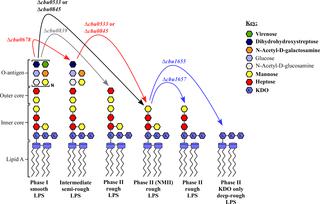PLoS Pathogens ( IF 6.7 ) Pub Date : 2018-02-26 , DOI: 10.1371/journal.ppat.1006922 Paul A. Beare , Brendan M. Jeffrey , Carrie M. Long , Craig M. Martens , Robert A. Heinzen

|
Coxiella burnetii is an intracellular pathogen that causes human Q fever, a disease that normally presents as a severe flu-like illness. Due to high infectivity and disease severity, the pathogen is considered a risk group 3 organism. Full-length lipopolysaccharide (LPS) is required for full virulence and disease by C. burnetii and is the only virulence factor currently defined by infection of an immunocompetent animal. Transition of virulent phase I bacteria with smooth LPS, to avirulent phase II bacteria with rough LPS, occurs during in vitro passage. Semi-rough intermediate forms are also observed. Here, the genetic basis of LPS phase conversion was investigated to obtain a more complete understanding of C. burnetii pathogenesis. Whole genome sequencing of strains producing intermediate and/or phase II LPS identified several common mutations in predicted LPS biosynthesis genes. After passage in broth culture for 30 weeks, phase I strains from different genomic groups exhibited similar phase transition kinetics and elevation of mutations in LPS biosynthesis genes. Targeted mutagenesis and genetic complementation using a new C. burnetii nutritional selection system based on lysine auxotrophy confirmed that six of the mutated genes were necessary for production of phase I LPS. Disruption of two of these genes in a C. burnetii phase I strain resulted in production of phase II LPS, suggesting inhibition of the encoded enzymes could represent a new therapeutic strategy for treatment of Q fever. Additionally, targeted mutagenesis of genes encoding LPS biosynthesis enzymes can now be used to construct new phase II strains from different genomic groups for use in pathogen-host studies at risk group 2 level.
中文翻译:

伯氏柯氏杆菌脂多糖相变的遗传机制
伯氏柯氏杆菌是一种引起人Q发热的细胞内病原体,这种疾病通常表现为严重的流感样疾病。由于高传染性和疾病严重性,病原体被认为是第3类危险生物。全长脂多糖(LPS)是C充分毒力和疾病所必需的。Burnetii,是目前由免疫能力强的动物感染所定义的唯一毒力因子。具有光滑LPS的强力I期细菌向具有粗糙LPS的无毒II期细菌的转化发生在体外传代过程中。还观察到半粗糙的中间形式。在这里,对LPS相转化的遗传基础进行了研究,以获得对C的更完整的了解。伯内蒂发病。产生中间和/或II期LPS的菌株的全基因组测序鉴定了预测的LPS生物合成基因中的几个常见突变。在肉汤培养中传代30周后,来自不同基因组的I期菌株在LPS生物合成基因中表现出相似的相变动力学和突变升高。有针对性的突变和遗传互补使用新Ç。基于赖氨酸营养缺陷型的Burnetii营养选择系统证实,六个突变基因是生产I期LPS所必需的。在C中破坏这些基因中的两个。伯内蒂I期菌株导致II期LPS的产生,表明对编码酶的抑制可能代表了Q热的新治疗策略。此外,编码LPS生物合成酶的基因的定向诱变现在可用于构建来自不同基因组的II期新菌株,用于2级风险组的病原体宿主研究。


























 京公网安备 11010802027423号
京公网安备 11010802027423号